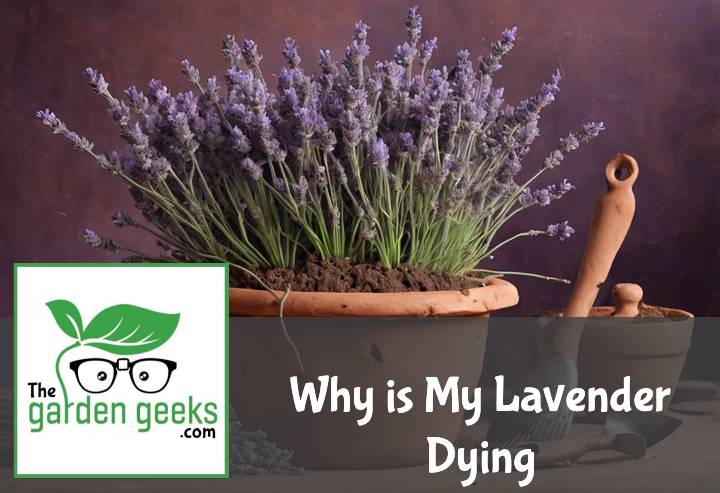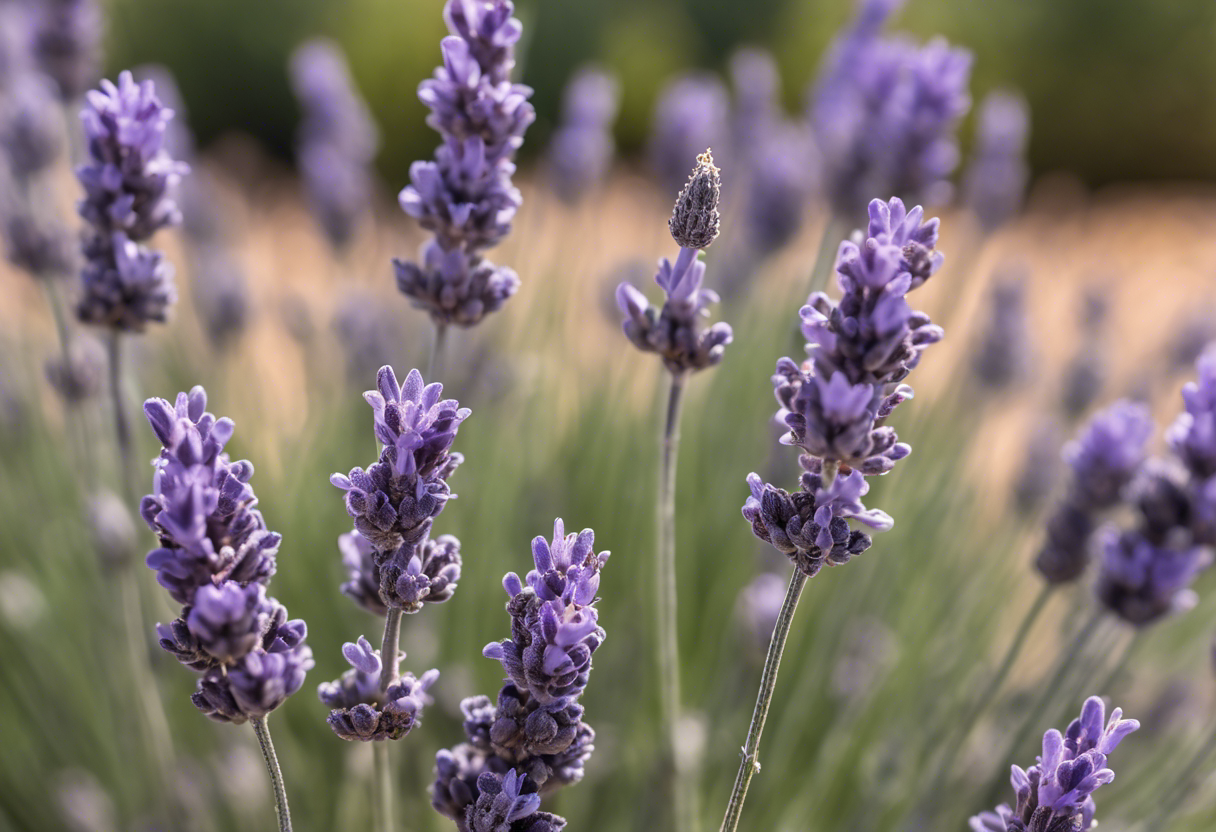Ever woke up, sipped your morning coffee, and thought to yourself, “Why is my lavender dying?” Well, you’re not alone. This is a common cry for help from many garden enthusiasts like us. Lavender plants can be a bit of a drama queen sometimes, especially when they don’t get their way.
But worry not! We’ve got some foolproof solutions that actually work. So put on your gardening gloves and let’s dive into the world of Why is My Lavender Dying together! Keep reading about Why is My Lavender Dying? (8 Solutions That Actually Work).
Key Takeaways
- Lavender plants may die due to overwatering, poor soil drainage, insufficient sunlight, or extreme temperatures.
- To revive your lavender, ensure it gets at least 6 hours of sunlight daily and plant it in well-draining soil.
- Avoid overwatering; let the soil dry out between watering sessions.
- Protect the plant from extreme cold and heat.
- Regular pruning promotes growth and prevents disease.
- Use a slow-release fertilizer for nutrient supply.
- Treat pests and diseases promptly with appropriate remedies.
Understanding Lavender Plants
Ah, the lovely lavender! Originating from the Mediterranean, this plant is known for its vibrant purple flowers and soothing scent. But understanding lavender plants isn’t just about appreciating their beauty. It’s also about knowing their quirks and needs.
The Importance of Lavender’s Native Environment
You see, lavenders are like that friend who loves to vacation in sunny Spain and can’t stand cold weather. They thrive in their native environment, which is warm with well-drained soil. So if you’re wondering ‘Why is My Lavender Dying‘, it might be because it’s not getting enough of that Mediterranean love.
Replicating these conditions can be a bit tricky but it’s crucial for your lavender’s health. Think of it as creating a mini-Mediterranean at home. Your lavender will thank you by growing beautifully!
How Lavender Plants Function
Now let’s talk about how these beauties work. Understanding the lavender growth cycle is like understanding the plot of a good book. It has its ups and downs, twists and turns.
Lavenders have specific requirements to stay healthy. They need plenty of sunlight, moderate water, and well-draining soil. If any of these factors are off balance, your lavender might start throwing a tantrum (read: wilting).
Remember, every plant has its own rhythm and lavenders are no different. So keep an eye on your plant’s needs and adjust accordingly!
Common Reasons Why Your Lavender is Dying
Ever wondered, “Why is My Lavender Dying?” Well, it could be due to overwatering, insufficient sunlight, poor soil conditions, or extreme temperature changes. Let’s dive into these common lavender problems and discuss some dying lavender solutions.
Overwatering and Root Rot
Overwatering is a common culprit when it comes to lavender plant care. Too much water can lead to root rot in lavenders. This happens when the roots become so saturated that they can’t breathe.
The result? A sad, droopy lavender plant showing clear lavender overwatering symptoms. The key here is balance – lavenders need water but not too much! So how do you prevent root rot?
Well, proper watering for lavenders involves letting the soil dry out between waterings. This prevents the roots from sitting in water and developing rot.
Insufficient Sunlight Exposure
Another reason why your lavender might be on the fritz? Insufficient sunlight exposure. Lavenders love the sun – they thrive in full sunlight conditions.
If your plant isn’t getting enough light, it’ll show signs of stress. These include pale leaves and stunted growth – classic effects of low light on lavenders.
To keep your lavender happy and healthy, ensure it gets at least six hours of direct sunlight each day. That’s the optimal light for lavender growth!
Poor Soil Conditions
Poor soil conditions are another biggie in the “why is my lavender dying” saga. Lavenders prefer well-draining soil with a neutral to slightly alkaline pH.
If your soil doesn’t meet these lavender soil requirements, your plant may struggle to thrive or even survive! But don’t worry – improving soil for lavenders isn’t rocket science.
You can improve your garden’s soil by adding organic matter like compost or well-rotted manure. This will help improve drainage and provide essential nutrients for your lavender.
Extreme Temperature Changes
Last but not least, extreme temperature changes can wreak havoc on your lavender plant. Lavenders are hardy plants, but they do have their limits when it comes to temperature tolerance.
If temperatures fluctuate too much, your lavender may show signs of stress. These include wilting leaves and a lack of new growth – clear effects of temperature fluctuations on lavenders.
To protect your lavender from such changes, try to keep it in a location where the temperature remains relatively stable. And remember – while lavenders can handle the cold, they really don’t like wet feet in winter!
Solutions That Actually Work to Revive Your Dying Lavender
Ever wondered, “Why is My Lavender Dying“? Well, it’s time to stop scratching your head and start taking action. Here are some practical solutions for lavender care that can help you revive dying lavender.
Adjusting Watering Practices
First things first, let’s talk about water. Too much or too little can turn your lavender into a wilting mess. Overwatering causes root rot while underwatering leaves them parched and thirsty.
The trick is to find the Goldilocks zone of watering – not too much, not too little, but just right. So how do you achieve this? It’s all about understanding your plant’s needs and adjusting accordingly. Remember, lavenders prefer well-drained soil and don’t like having wet feet!
Ensuring Adequate Sunlight Exposure
Next up on our effective lavender revival methods, we have sunlight exposure. You see, lavenders love the sun; they’re basically sunbathing beauties in the plant world!
Without enough light, they can become weak and leggy – definitely not a good look! So make sure your plants get at least 6 hours of direct sunlight each day for healthy growth.
Improving Soil Conditions
Now let’s dig into soil conditions. The quality of your soil plays a huge role in your lavender’s health. If it’s poor quality or doesn’t drain well, you could be sending an invitation to root rot city!
To improve soil conditions for lavenders, consider adding organic matter or sand to enhance drainage. And remember: Lavenders prefer slightly alkaline soils.
Protecting from Extreme Temperatures
Last but certainly not least on our list of tips for healthy lavender growth, we have temperature control. Lavenders may love the sun, but extreme temperatures? Not so much.
High heat can cause wilting, while freezing temperatures can lead to frost damage. To protect your plants from temperature extremes, consider using mulch in summer and a protective cover in winter.
Preventative Measures for Healthy Lavenders in the Future
If you’ve ever asked yourself, “Why is My Lavender Dying?”, then this section is for you. We’ll be delving into preventative measures that can keep your lavenders blooming and healthy.
Regular Monitoring and Care
Taking care of your lavender plants involves more than just watering them. It’s about lavender plant monitoring and routine checks. You see, lavenders are like babies; they need constant attention to thrive.
By caring for lavenders, you’re able to spot any issues early on. This could be anything from a change in leaf color to stunted growth. And with routine lavender care, these problems can be nipped in the bud before they escalate.
Choosing the Right Location for Planting
Choosing where to plant your lavender is like picking out a house. The location matters! The lavender planting location plays a huge role in determining how well your plant grows.
Lavenders love sunlight, so areas with plenty of it are ideal. They also have specific soil preferences, so consider this when choosing where to plant them. Remember, the best place to plant lavenders is somewhere they’ll feel at home!
To Wrap Up
Just like a detective solving a whodunit, we’ve delved into the mystery of Why is My Lavender Dying. From overwatering to poor soil, we’ve unpacked the main culprits and offered solutions.
Remember, your lavender isn’t just a plant—it’s a garden diva that needs the right spotlight and stage. Treat it well and you’ll enjoy its fragrant performance for years to come!





